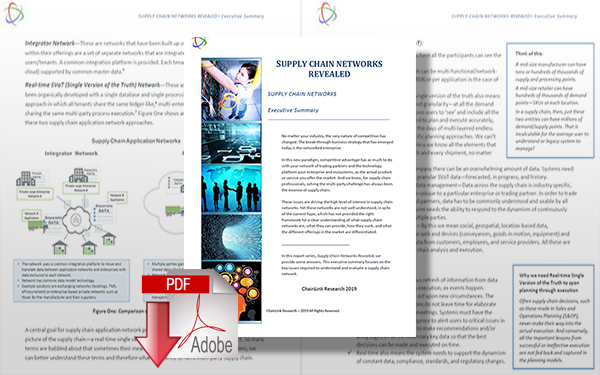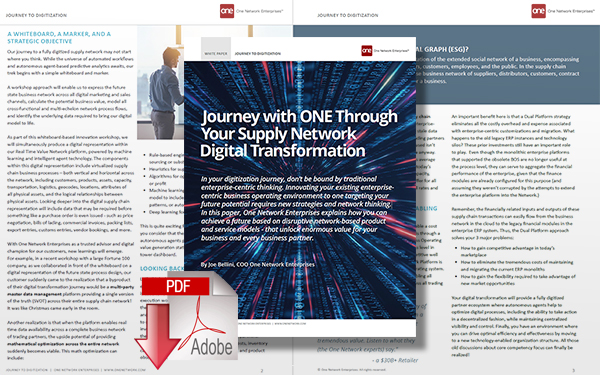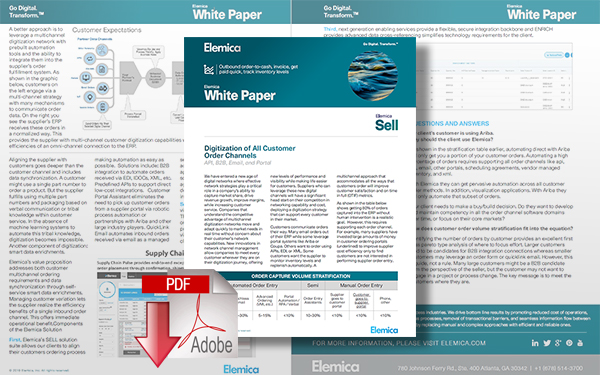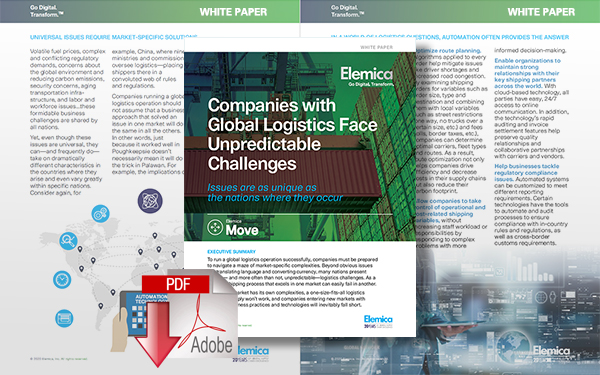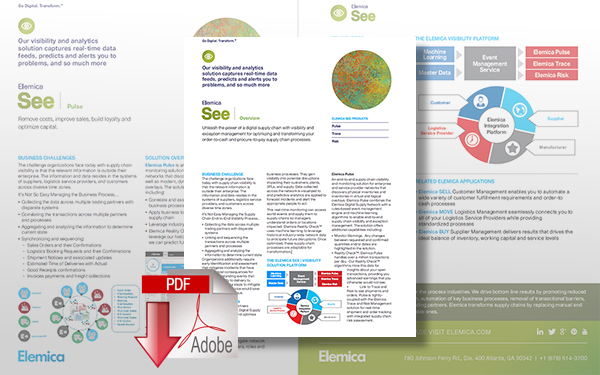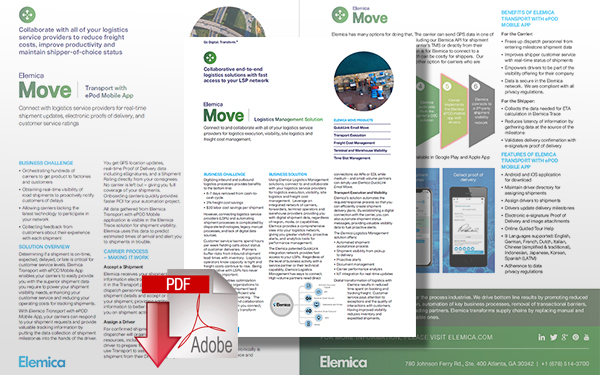The Current State of Digital Supply Chain Transformation

Industry experts and analysts discuss how far we’ve come and how far we still have to go down the path to complete digitalization of the supply chain.
Digital Transformation
In an assessment of how organizations have progressed down the digital transformation path over the last few years, Capgemini Research Institute found that while worldwide spending on digital transformation technologies - hardware, software, and services - will cross the $2 trillion mark by 2021, organizations are struggling with both the digital and leadership capabilities required for success.
For example, just 35% of companies are monitoring their operations in real-time (versus 48% in 2012, the last time Capgemini conducted this research), 29% are modifying their operational processes to adapt quickly to external changes (versus 34% in 2012), and only 38% are giving employees the tools they need to collaborate digitally with one another (compared to 70% in 2012).
According to the research team at Capgemini, implementation challenges, and the increased complexity of technology are the primary roadblocks for organizations that are trying to progress down the digitalization path.
The Digital Supply Chain
The same can be said for the digital supply chain, where advancements in hardware and software can effectively “lead the horses to water,” so to speak, but can’t always drive them to actually put the technology to good use in their operations.
A number of our top supply chain software analysts contend that the good news is that many supply chain and logistics operations are experiencing positive results from their investments in transportation management systems (TMS), warehouse management systems (WMS), yard management systems (YMS), global trade management systems (GTM) and other supply chain solutions.
Whether they’re using these systems on a “best of breed” basis or bundling them under enterprise resource planning (ERP) systems, shippers are turning to software that helps them improve their efficiency and productivity.
Closing the Loop: Cloud the De Facto Solution
An innovation that has driven more companies to invest in a broader range of technology, the Cloud continues to gain steam in the supply chain.
Calling Cloud the “fastest-growing market segment,” Gartner says its use increased by 27.5% in 2019 reaching $38.9 billion (up from $30.5 billion in 2018).
“At this point, Cloud has become the de facto solution, with many providers pushing their potential and existing clients to upgrade in the direction of Cloud,” says Bob Hood, a Capgemini principal, and lead for the group’s Move Domain practice.
“That’s where all of the new product development is taking place across all of the different supply chain solution areas.”
Leading the pack on the Cloud front are TMS and WMS, with the former being among the first supply chain execution (SCE) applications to move into the Cloud. Hood says shippers’ thirst for more supply chain transparency and visibility is driving higher investment in Cloud TMS and WMS in 2020, with companies like Kuebix, project44, FourKites, Elemica, One Network Enterprises, and E2open all working to provide higher levels of real-time visibility across warehouses and transportation networks.
The need for better visibility tools also radiates out into the broader supply chain, where companies need to know what’s happening with their inventory and their transactions.
“Companies are trying to go beyond being just execution-focused and effectively ‘close the loop’ on the end-to-end supply chain,” says Hood. “Getting there requires more collaboration, orchestration, and the integration of planning with execution.”
The Data-Robot Connection
In a world that will be generating 463 exabytes of data daily by 2025 - or 212,765,957 DVDs per day - the need for good data analytics and reporting transcends all industries and organizations. Hood says shippers are aware of this, and that’s led to a “heavy emphasis” on connecting supply chain data and analytics in recent years.
For example, with the goal of improving their logistics and supply chain operations, companies are slicing and dicing their data and then using it to make good decisions. They’re also harnessing the available transaction data that they didn’t capitalize on previously. From their software vendors, companies need tools that can help them turn transactional data into useable information.
By infusing advanced technologies like artificial intelligence (AI) and machine learning (ML) into their platforms, vendors are helping companies further their digital agendas. “Companies can learn from their data and understand the behaviors that drive higher productivity and better efficiencies,” says Joe Vernon, Capgemini’s practice leader of supply chain analytics. “That also links to the use of robots and robotics process automation [RPA], where the data-robot connection feeds better problem-solving.”
A Mixed Technology Bag
In assessing the progress that shippers are making on the digitalization and automation front right now, Bart De Muynck, Gartner’s research vice president of transportation technology, says it’s a mixed bag. “Despite the fact that logistics is lagging behind sectors like manufacturing, which is using 3D printing to quickly ramp up face mask and nose swab production,” says De Muynck, “I think we’re on a good path right now.”
Pointing to increased TMS adoption as an example, De Muynck says more companies are ditching paper, spreadsheets, and phone calls in lieu of more automated transportation management processes. He credits the emergence of Cloud TMS platforms - many of which are being offered up on a subscription basis - and therefore require little or no upfront capital investment - with driving some of that interest in TMS.
Other key drivers include the need for real-time transportation visibility and the new batch of digitized freight networks that entered the market over the last few years. “Instead of calling a broker, and then that broker calling a carrier,” says De Muynck, describing the new digital freight model, “the entire process is digitized from end-to-end.”
Reimagining the Warehouse
If Modex 2020 was any indication, the push to add more robots and automation to the warehouse setting is big right now. Challenged by high labor costs, high order velocities, and fast delivery times, companies are infusing more automation into their warehouse operations. This is yet one more example of how far supply chain organizations have come in the reimagination of their warehouses and DCs.
“The number of business use cases involving robotics has gone up pretty dramatically versus anything we’ve seen before,” says De Muynck. He’s seeing similar momentum on the software side, where vendors continue to push the envelope on digital supply chain transformation. Pointing to JDA’s rebranding as “Blue Yonder,” (an AI/LM company that it acquired) as one example of this, De Muynck says the former’s adoption of that name reveals its commitment to infusing more AI into its solutions.
“Although the company is still selling a supply chain management suite application,” explains De Muynck, “it’s now layering AI on top of its JDA Luminate, with the goal of becoming known as more of a ‘digital platform.’”
Systems Upgrade or Replacement?
As a supply chain expert who tours hundreds of different warehouses during any given year, Ian Hobkirk, founder, and president at Commonwealth Supply Chain Advisors, says SCE software adoption varies according to the application itself and the industry in question. Where Distribution Centers with 50+ employees usually have a WMS in place, for example, some smaller operations continue to rely on manual systems.
Of the WMS currently in use, some of the older systems are now in need of upgrade or replacement. “Some early adopters of WMS over-customized their systems, so now they have a decision to make,” says Hobkirk. For example, a current Oracle, SAP, or Microsoft ERP user may now want to fold WMS, TMS, or even YMS under the same umbrella with their enterprise platforms. Others are looking at best-of-breed or Cloud-based options.
“There are other companies that implemented systems 10 years ago and realize that the solutions aren’t really working very well, but they just decided to live with it,” says Hobkirk, who sees no immediate end in sight for that trend. “Companies just don’t want to take the risk of putting the organization through a big IT project that might not be successful.”
Outside of the Warehouse Four Walls
Looking outside of the warehouse’s four walls, Hobkirk says many companies are still managing their transportation spend manually. “They just don’t realize how much money they’re leaving on the table by doing that,” he points out.
As for YMS, Hobkirk says that while large companies with big yards and a high volume of trailers appreciate its orchestration capabilities, adoption rates for YMS remain relatively low across the board. “Some companies can’t quite connect the dots on what the YMS-related savings are going to be,” he adds, noting that the software provides “pretty good payback” for larger operations.
In pinpointing other underutilized software applications, Hobkirk says he’s surprised that more companies aren’t using labor management systems (LMS), slotting, and inventory optimization solutions. “These solutions are all underrated,” he says, “and not very well adopted.”
For instance, he says on-demand/subscription-based LMS offers a viable business case for operations that can’t justify an investment in automation, but that want to eke more productivity out of their workforces. “LMS is a safe software to implement; it’s not risky,” says Hobkirk. “You don’t shut the warehouse down if LMS fails and it almost always delivers some degree of savings.”
Ramping Up Digital Supply Chain Initiatives
As companies continue to shake off the impacts of the COVID-19 crisis and look to the future, more of them will surely continue to make headway with their digital supply chain initiatives.
From the crisis, many learned the true value of end-to-end supply chain visibility - something that De Muynck says could drive higher SCE adoption in the near future. “Companies are going to continue to invest in the technologies that support good global supply chain visibility,” says De Muynck. “Even in the midst of the crisis, we saw companies investing in these solutions. That’s not going to let up anytime soon.”
Related Papers
Supply Chain Networks Revealed
A new study from ChainLink Research explains the new paradigm in supply chains that are accelerating business growth and performance – and identifies One Network Enterprises as a Leader in this technology space. Download Now!
Journey Through Your Supply Network Digital Transformation
In this paper, One Network Enterprises explains how you can achieve a future based on disruptive network-based product and service models - that unlock enormous value for your business and every business partner. Download Now!
8 Keys to Achieving Success with Artificial Intelligence in Supply Chain
This white paper looks at the fundamentals that supply chains need in place in order to achieve real results from Artificial Intelligence implementations. Download Now!
Digitization of All Customer Order Channels - API, B2B, Email, and Portal
This white paper describes a company’s ability to capture market share, drive revenue growth, improve margins while increasing customer service is improved by connecting to a multichannel digitization network. Download Now!
Companies with Global Logistics Face Unpredictable Challenges
This white paper describes how automation technology helps companies manage market-specific issues by delivering full visibility into all facets - and every location - of their shipping and logistics operations. Download Now!
The Elemica SEE | Visibility Solution Platform
Unleash the power of a digital supply chain with visibility and exception management for optimizing and transforming your order-to-cash and procure-to-pay supply chain processes. Download Now!
The Elemica MOVE | Logistics Management Solutions
Connect to and collaborate with all of your logistics service providers for logistics execution, visibility, site logistics, and freight cost management, and digitize shipment responses quickly and cost-efficiently from your transportation providers for shipment booking and milestone visibility. Download Now!
More Resources on Digital Transformation
Article Topics
Blue Yonder News & Resources
Women in Supply Chain: Ann Marie Jonkman of Blue Yonder Blue Yonder announces an agreement to acquire One Network Enterprises for $839 million Blue Yonder Acquires One Network Enterprises for $839M Frictionless Podcast: Understanding Your Supply Chain Goals with Ann Marie Jonkman Blue Yonder announces acquisition of flexis AG Supply Chain Management (SCM) applications keep the supply chain humming How Collaborative Efforts Can Enhance Reverse Logistics More Blue YonderLatest in Supply Chain
How Much Extra Will Consumers Pay for Sustainable Packaging? FedEx Announces Plans to Shut Down Four Facilities U.S. Manufacturing is Growing but Employment Not Keeping Pace The Two Most Important Factors in Last-Mile Delivery Most Companies Unprepared For Supply Chain Emergency Microsoft Unveils New AI Innovations For Warehouses Let’s Spend Five Minutes Talking About ... Malaysia More Supply ChainAbout the Author




